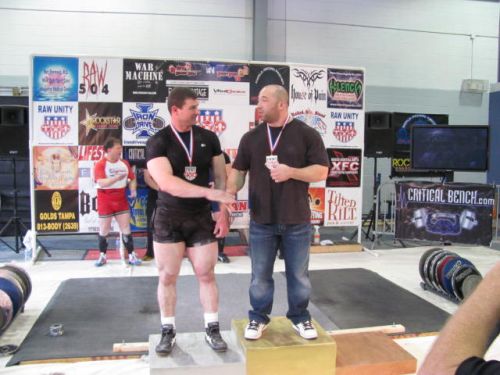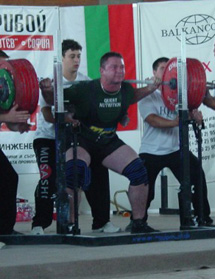Choosing Sets and Reps Part II
by Mike Tuchscherer

In part one of this article, we barely scratched the surface of how to choose your set and rep protocols. We spent most of our time discussing training objectives and how they differ from larger training goals. We also discussed a good general sequence for training objectives, though I left the specific programming up to you. And as you recall, we finished the article with an easy example of how to select a protocol for hypertrophy.
Selecting the appropriate protocols for other training objectives is not much more difficult. You simply adjust the training variables until they suit the development of your targeted objective. Variables such as reps, RPE, stress, training time, rest intervals, intensity, and tempo all need to be controlled. Now, this isn't as hard as it looks, though it can be as complicated as you want to make it. If you are a Rated Lifter on the Russian Classification Chart, you still don't need to make it very complicated. Only once you begin reaching your limits do you need to be so specific to squeeze out every last drop of potential you have.
We can eliminate some of these variables right away. If you are familiar with how RTS does things, you'll remember that sets should be determined by the amount of stress you are trying to create. It is the recovery from stress that stimulates adaptation, so inducing an appropriate level of stress is more important that simply doing a preset number of sets. For more information on how to do this, please see The RTS Manual. And rather than focus on the other variables to control, I want to continue discussing how to select your specific loading parameters - "sets-n-reps".
If we eliminate sets on the basis of RTS-style stress management, then we're left with reps... oh, and RPE, because that is also an important consideration.
I have said before that the intensity (bar-load) determines the majority of your training effect. As the load on the bar increases, greater emphasis is placed on the force of the muscular contraction and less on the metabolic energy in the muscle fibers. This is a basic way to look at it, but true nonetheless. So choosing your bar load becomes easier once you have your objectives in place.

If you are planning a peaking cycle and are attempting to realize sport form, you will need a high intensity of movement. This necessitates relatively high bar weight. You will also want to utilize fairly high RPE's to further replicate the contest requirements and heighten sport form. This will necessitate lower repetitions. The number of sets required is based off the level of training stress you want to induce.
Likewise, if you are planning a hypertrophy cycle, you know you are trying to stimulate an acute lack of ATP in the muscle fiber (a leading theory of what stimulates hypertrophy). If you have been doing your physiology homework, you also know that this means you will need a set to require high effort (8+… really 9+ RPE's) and last ~30-40 seconds. This will likely put you in the 6-12 rep range, depending on the Range of Motion and Tempo of the lift. Sprinkle in some RTS-style fatigue management to get the perfect number of sets and viola, you're doing some serious hypertrophy work!
Clearly there are far too many physiological objectives for me to highlight protocol parameters for each of them in this article. The point of these two examples was more to serve as an example of a thought process. If you have become a student of the sport and learned some physiology, this will be a bit easier.
After you have identified your objectives, you will want to relate them to what changes are taking place in the body. If they are physiological changes (such as hypertrophy or increasing energy reserves), then continue to identify how those changes will take place (adaptation to stress on those structures). And now you just match up your needs (stress on certain structures) with the tools in your tool box (exercises and protocols).
Let's work through another example together. In this case our over-arching goal is to Bench Press 225 for as many reps as possible. Our athlete can already do 12, so we are seeking to improve his muscular endurance with 225. Let's assume we are in the middle stages of the cycle and we are trying to improve general muscular endurance. Since we are all good coaches and have done our physiology homework, we know that 12 reps will take approximately 20-35 seconds for most athletes. This will likely push the athlete beyond his ATP/CP energy systems and into the Anaerobic Glycolytic system. There are a few ways to improve muscular endurance. You could build his 1RM, thereby requiring less effort to move 225. This will preserve some energy and he can keep performing longer, and thus more reps. Or you could address the energy systems themselves. By taxing the energy systems, the body will compensate by making those systems more efficient and sometimes even with greater stored energy. Both are valid approaches and both have their place in the training cycle, but since what we really want to know is about "sets-n-reps", let's just follow one.
For this example, let's work through the process of trying to improve the energy reserves of this athlete. We already identified which systems need work. Now the task is to tax those systems. The protocols that are selected should put him in similar environments as the contest movement… and then slightly longer durations. This will effectively tax the energy systems required and the body will respond by improving those structures - making them better, stronger, and longer lasting.
If this article was as hard to understand as it was to write, post something on the forum. This is highly important stuff to get your training on the best, most efficient path possible. Sometimes it can be difficult to understand, but keep with it and it will pay off for you. You'll understand how to put your own programs together as well as identify if some other program you've been thinking about is actually worth its salt. So if you want to "get it" and you don't, ask the question and let's get some dialogue going!
Mike Tuchscherer is the owner of Reactive Training Systems, a company dedicated to individualized physical training. The goal of RTS is to help you become a dominant force in your sport! Learn more by visiting www.ReactiveTrainingSystems.com.
Mike himself is an accomplished Powerlifter. He has over 12 years of experience training and researching the best training methods in the world. Mike has competed in raw and single ply competitions. He recently won the Gold medal representing the USA at the 2009 World Games; becoming the first American male to ever win this distinction. His best lifts in IPF competition are a 903 squat, a 644 bench press, an 826 deadlift, and a 2342 total in the 275 pound weight class.
More Articles By Mike Tuchscherer
Return to the Workout Articles Archive
|